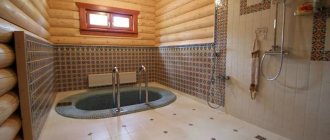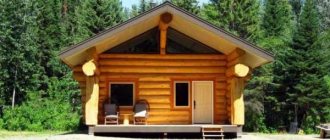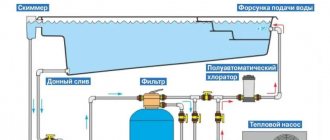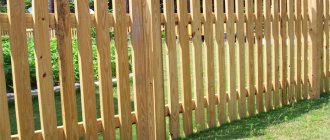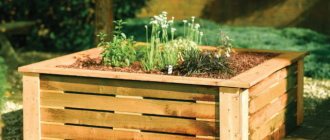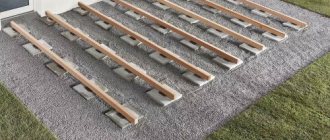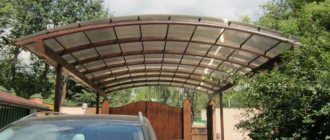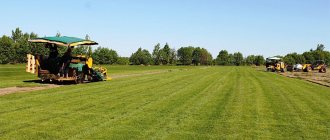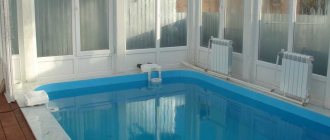Everything in the article is to help the reader. how to make a pier on a lake with your own hands, photographs, technology, materials, tools, construction time.
A fishing bridge, masonry, pier, not a single area near a reservoir can do without it. You have become the happy owner of such a plot, but bad luck, the lake or pond is not a river, the bottom is muddy, and no company will undertake to build a pier here.
I found myself in the same situation, found a contractor, looked at their work, called them on the phone, explained the situation, they took over, but the team that arrived, after a test entry into the reservoir with a screw pile, refused to work further. The conclusion is not comforting - a swamp. Although I must tell you that before this we swam in the river, and came out of the water with clean feet, although sometimes there was soft soil under our feet, over hummocks, over hummocks and onto the banks.
The fish were caught wonderfully from the shore; I cleaned the bottom of the reeds with a bottom scythe. I wanted to clear the bottom of silt and deepen it, but no one took on such a small volume. So it was decided to build a pier on the lake with our own hands. You can swim, fish, or moor a boat with a motor from it.
Materials for pier construction
No sooner said than done, especially since all that was left from the construction of the house was scaffolding:
- timber 150x50x6m, easier to say board
- inch board 25x6m
It was decided to use all this stuff in the construction of a future fishing masonry or pier in one person.
Construction of berths on pile foundations
In Russian villages located along the banks of deep rivers, you can see wooden piers for fishing boats built on pile foundations. Previously, hard wood was used as piles. Most often, larch, oak or alder logs were used. Currently, preference is given to metal piles, which can be driven or screwed. These types of piles differ from each other in structure, as well as in the installation method.
Option #1 - driven piles
Driven piles are made in the form of steel pipes equipped with a pointed tip. These piles are driven into the ground using pile drivers (pile driving machines). This installation method can negatively affect the condition of the metal. The pile can be “driven” and even twisted into a spiral. In the event of such deformation of the metal, the pile will not reach the layer of solid soil, which means it will not be able to be a full-fledged support for the berth being constructed. It is not always possible for special equipment to arrive at the construction site of a berthing structure. Therefore, when constructing a pile foundation with your own hands, screw piles are used.
Option #2 – screw piles
A screw pile, like a driven one, is made of a metal pipe. A blade of a certain configuration is welded near its lower cone-shaped end, and at the other end - a head necessary for attaching the base of the future berth. Thanks to this blade-screw, the pile is easily screwed into the bottom soil, without having to exert too much physical effort. During smooth rotation, the screw pile evenly enters the ground. The risk of deformation of the pipe walls is minimal. The length of screw piles can reach 11 m. If necessary, the pipe can be extended or, conversely, cut.
Installation of a wooden pier of complex shape in winter greatly simplifies the work. You can easily reach any construction site on ice
The greater the load the pile must withstand, the larger the diameter of its trunk should be. In this case, the thickness of its walls also matters.
Rules for installation work
Before starting installation work, it is necessary to calculate the exact number of piles and select the required diameter taking into account the load. Calculate the minimum distance between adjacent piles at which the grillage material will not sag. The length of the piles is selected based on the type of soil and the depth of its freezing in a given area.
After screwing the screw pile to a certain depth, concrete (grade M300 and higher) is poured into the cavity of its shaft. This technique increases the load-bearing capacity of the supporting element. When installing a pile foundation in winter, special additives are added to the concrete solution. By the way, it is preferable to install piles for the pier in winter. It is much more convenient and cheaper to carry out work on ice than in water. If the soil is heterogeneous in structure, then the piles are installed at different depths, and then leveled to a given level.
Recent Entries
Lilac perennials that are beautiful, compact and do not crowd out other plants Why when buying seedlings you should not take the sellers’ word for it and how to determine the age of the plant using 3 signs Tomato seedlings have turned purple or whitish: why the color has changed and how to save the plants
Schematic illustration of a wooden pier built on a pile foundation. The length of screw piles is determined by test drilling, during which you can find out the depth of hard layers of soil
Screw piles are suitable for repeated use. They can be screwed in, and if it is necessary to dismantle the surface structure, they can be unscrewed. However, it is not recommended to fill the pile shaft with concrete. Screw piles can last for several decades, especially if their surface is treated with a special chemical composition. This means that a pier built on a pile foundation can be used for a long time.
Separate piles are combined into a single structure using a channel welded to their heads. Sometimes timber is used as a connecting link. All welding seams need to be treated with a special compound based on epoxy resin, enamel or paint. This coating protects seams in humid environments from corrosion.
It is impossible to install a pile foundation on rocky soils. In this case, other options for constructing berths and piers are considered.
Waterproof wood of valuable species (larch, acacia, ipe, cumaru, garapa, bangirai, massaranduba, merbau) is used as materials used for laying flooring on berths and piers. Each type of expensive wood has its own unique color and special texture. Construction can be made cheaper by using modern water-repellent polymer and wood-polymer materials, on the basis of which special deck and terrace boards are made. These materials are ideal for the construction of above-water structures because:
- do not give in to the process of rotting and decomposition from exposure to humidity and precipitation;
- are not subject to deformation because they do not dry out, swell, bend or warp, warp or crack (unlike many types of natural wood);
- are able to withstand significant temperature changes and exposure to ultraviolet radiation without loss of decorative qualities;
- have high resistance to abrasion;
- withstand heavy shock loads;
- has a non-slip corrugated surface that allows you to safely move along the pier during or after rain.
Polymer deck boards, used for installing decking on berths and piers, do not require protection with varnishes and oils, which greatly simplifies the maintenance of its surface.
Installation of wooden flooring on a rigid frame fixed to a pile foundation. Treatment of boards with protective compounds that protect them from premature wear
Installation of wooden flooring is carried out using hidden fastener technology. When finishing the finished berth, railings, descents into the water, as well as mooring fenders and other devices necessary for the operation of small vessels are installed.
Plastic floats for a pontoon or do-it-yourself pontoon
The main problem when choosing a floating structure is the large dimensions of the finished products. It often happens that the quality and cost are quite satisfactory, but transportation of the finished assembled structure is many times more expensive than the cost of the structure itself, especially if the pontoon is installed in hard-to-reach areas. In this case, you can order separately components - plastic floats for the pontoon, clamps and fasteners. With their help, it is possible to make a pontoon with your own hands with the dimensions you need directly at the installation site.
Molded plastic floats for pontoons.
Polyethylene floats are made by rotational molding, i.e. the products do not have welded seams. Today we produce two types of similar floats:
- series A floats - wall thickness from 6 to 9 mm with a load of up to 250 kg per float, optionally filled with foam;
- series B floats - load up to 400 kg per float, two-layer walls with a thickness of 12 to 25 mm with a foam layer (multi layers technology, more details...)
- C series floats - for the construction of stationary pontoons, with a wall thickness of up to 6 to 9 mm and a load of up to 400 kg.
The float draft at full load is no more than 2/3 of the float height.
Floats of the A and B series have guides on the end part of the product for making a chain of floats. This design ensures rigid fixation of the floats at the base of the floating structure, which prevents displacement of the floats relative to each other when used in self-propelled pontoons or during large waves as part of a stationary pontoon.
| Serie A |
| Serie B |
In the upper part of the floats there are niches for installing a frame and a log for the flooring, as well as holes for fixing the frame and flooring to the float body.
Pontoon assembly procedure
An example of assembling a simple pontoon pier
To build a small pontoon-type berth, they purchase wooden beams, planed boards, nails, screws, metal corners, 200-liter barrels and ropes to secure them. The square frame of the structure is assembled from timber with a section of 100 by 50 mm on the shore. The side length of the square is 2.5 meters. The frame is reinforced at the corners with additional wooden blocks. The corners of the frame structure must be straight (90 degrees).
The structure, assembled from wooden beams and sealed barrels, is an example of the simplest pontoon-type pier providing access to a reservoir
The buoyancy of the berth is provided by four 200-liter barrels, previously used for storing petroleum products. The barrels must be absolutely airtight. To ensure this requirement, sealant or silicone is applied around the plugs to prevent water from getting inside the containers. For better fastening of the barrels to the frame structure, use additional bars (50 by 50 mm), which are attached to the main frame using metal corners. Holes are drilled in these bars through which ropes are pulled to securely fasten the barrels located on both sides of the frame, parallel to each other.
The inverted frame, ready for launching, is transferred to a reservoir without flooring, which will increase its weight several times
Then the rectangular wooden frame is turned over, with the barrels ending up at the bottom of the structure. In this position, the structure is installed in a reservoir near the shore. An anchor system is used to secure it. You can also tie the structure to a pile screwed into the ground on the shore of a reservoir, or to a pole driven into the ground and concreted. At the last stage, the planed board flooring is nailed to the frame. A small bridge is also being built to provide access to the pier from the shore of the reservoir.
Final view of the pontoon pier used in the summer. With the onset of cold weather, the above-water structure is dismantled and stored until the next season
Wontons with mushrooms
If you love mushrooms or have eliminated meat from your menu, then check out these vegetarian wontons. Recipe:
- Grind 200 grams of Chinese cabbage and 80 grams of celery using a blender.
- Chop 100 grams of champignons and one with a knife, and then fry in a frying pan until tender.
- Season the minced meat with soy sauce, add onion, cilantro and ginger to taste.
- Prepare the dough (you can find the recipe above) and roll it into a thin layer.
- Cut the dough into squares, place the filling in the center of each and form bags.
Wontons need to be steamed until cooked. You can serve them with an original sauce, which is prepared from the following products:
- Light soy sauce – 30 ml.
- Sesame oil - half a teaspoon.
- Dark - half a teaspoon.
- Red pepper is hot.
- Ginger – one teaspoon.
We hope that you will enjoy the recipes collected in this article and that you will delight your family with new dishes every day.
You are the happy owner of a house near a pond, you probably imagined a bridge in the middle of the lake, where in calm weather you can go fishing or just sit, enjoying the smooth surface of the water or the rustle of the surf. Of course, you can build a permanent concrete bridge, or you can resort to a more romantic method and create a floating bridge. Such a pier is based on pontoons, which help the pier stay on the surface. We make pontoons from barrels with our own hands.
The only drawback will be the high price. If you want to save your family budget, you can use plastic barrels.
What to do if your pier floats away?
The owner of a plot facing a river or lake can build simple above-water structures on his own. Piers extending several meters from the shore deep into the reservoir should be built by companies with competent specialists and professional equipment. If you save on the design and construction of a pier by inviting dubious companies to carry out the work, you can “lose” the surface structure. It will simply float away from the shore.
- Author: marika
Rate this article:
- 5
- 4
- 3
- 2
- 1
(6 votes, average: 5 out of 5)
Share with your friends!
We nail 2 boards for space under our barrel.
Knock down 2 boards as in the photo. Between these planks we place our barrel. We secure the barrel to the current raft using tape or something else. You need to fasten the barrel and the skeleton of the raft from boards at the beginning and at the end.
Hunting and fishing are a favorite pastime of many men. Sitting with a fishing rod early in the morning in the reeds is a special romance for a fisherman.
Vehicles for fishing, and just for walking, are used in different ways - rubber, aluminum, boats made of PVC and even plywood.
You can buy absolutely any watercraft, if only you had the money, but how can you make a boat with your own hands? We'll tell you in our article.
A gentle method of arranging support
This method is recommended for constructing walkways in an artificial pond. The main advantage of this method is that it does not violate the waterproofing of the reservoir. In addition, such installation of supports is much easier than conventional screwing in piles.
What this method consists of: at the stage of waterproofing the pond, the piles are installed in a plastic container, which is filled with concrete; The container is installed at the bottom of the pond on top of the film. The load-bearing supports of the structure on the shore must be installed on the foundation. This design will be no less durable than walkways on screw piles, and it will serve regularly for several decades.
To make such a gentle design you will need:
- large plastic containers (according to the number of piles). The diameter of the container must be 8 or more times greater than the width of the pile;
- piles;
- concrete solution;
- protective fabric;
- paving slabs;
- waterproofing film;
- composition for internal waterproofing of concrete or waterproof glue;
- stones to decorate the pond around the pile.
Operating procedure:
- In those places where supports are planned, paving slabs must be placed under the pond film. They must be securely fastened and stable. Lay several layers of non-woven material on the tile to prevent the film from rubbing off.
This is an important stage. A strong foundation that can support the weight of concrete will ensure the reliability of the entire structure.
- Also lay several layers of fabric on the film. In size they should be quite a bit larger than the size of the tiles under the film. This must also be done so that the container with concrete does not rub off the film.
- Place a plastic container on the fabric. It should be exactly in the center of the tile!
- Place the pile and fix it in the middle of the container.
- Fill the container with the pile with concrete, leaving a few centimeters on top for a layer of decorative stones.
- Leave the concrete to harden for several days.
- Perform waterproofing: either treat the concrete around the pile with a waterproofing compound, or glue a pond film.
- Wait until completely dry, add stones.
The difficulty in this process usually arises with measurements. It is necessary to make sure that all supports are the same size, installed at the same level, and that in all containers (usually two are enough) the concrete is poured at the same level.
When the concrete has dried, the load-bearing beams can be secured and the structure of the walkways can be completed.
Video
We invite you to watch a video about self-building a pier from metal barrels.
Jokes New movies Music Auto Animals Sports
So, we decided to build a pier or a pier or a marina at the dacha, whatever you want to call it. Since we have a bathhouse on the shore of the pond, we want to jump straight from the steam room into the water. First, we took logs that were wide enough, sharpened them at one end and began driving them like piles into the bottom of the reservoir. To stay above the water, we took two six-meter beams, hung one edge over the pond, and placed a large counterweight (a huge stump and an anchor) on the other. We used another stump as a hammer, to which we attached bracket handles. Taking the stump from both sides, we began to drive piles. Only five pieces. Then they tied them with a floorboard (magpie) parallel to the shore line. And also ordinary boards between each other, for greater rigidity of the base. The piles were driven in at 40-60 centimeters. On the shore, a 20x20 beam was dug parallel to the strapping board. And they began to connect the board and beam with six-meter floorboards 40 and 50 mm thick. To make the plane more or less even, we tamped sand under the boards and compacted it, trying to maintain one level between the two outer guides. Then we extended our logs using the same boards to the junction with the path. The joints were made at different levels in order to obtain additional rigidity when covering with a finishing board. Then we laid three-meter boards, which will later be laid out at intervals of 1-2 cm and screwed with self-tapping screws. Every fifth board will cover the entire width of the berth - 6 meters, also for greater rigidity. In the future, a staircase into the water and a rope side will appear on the pier.
If your house or summer cottage is located on the shore of a picturesque lake or river, then sooner or later the thought of a small pier will come to your mind. It can be used in different ways and not necessarily for its intended purpose as a dock for a boat. The pier is a convenient place for fishing, a picturesque place for relaxation and, in the end, a banal place that is quite capable of replacing the beach. At the very least, kids will definitely prefer jumping from the pier to the flat sandy shore. Such a product will be discussed in this article, in which, together with the website, we will talk about how to build a pier with your own hands - we will look at two relatively simple options from which you can choose the most suitable one for yourself.
How to make a pier with your own hands photo
Types and design options for garden bridges
Stone, wood, concrete, metal - any of these materials are suitable for building a bridge. Their combination looks appropriate and even elegant, for example, combining medium-sized natural stone with processed wood.
The classification of buildings is quite arbitrary and is based rather on their design features.
Classic straight designs that fit harmoniously into any landscape picture. They can be wooden or concrete, with carved balusters or wrought iron lattice, entwined with ivy or painted in a contrasting color.
Few people will be able to make a forged bridge on their own, but there is a way out - order or buy a ready-made model
Curved, “humpbacked” structures look good against the background of the surrounding landscape - a garden, flower bed or hedge. The stone bridge will resemble a medieval building, and the airy wrought-iron bridge with floral ligature is the creation of St. Petersburg architects of the 19th century.
The bend of the bridge should not exceed 20 degrees
Zigzag structures are built according to the Japanese analogues of “yatsuhashi”. These are wooden decks located low to the ground. Their peculiarity is the absence of fences. An asymmetrical zigzag is appropriate for decorating a Japanese garden, including as a decoration for a “dry” stream.
Japanese zigzag bridges symbolize the difficult path of comprehending the truth.
- A hanging bridge over a ravine or stream looks a little extreme, but that makes it even more attractive. It is not customary to make such bridges at the dacha with your own hands, since they are technically complex and require material of special strength. The flooring is located on chains or metal cables, which require special fastenings.
- The step path bears little resemblance to the usual version, because it consists of flat stones placed on the bottom of a shallow stream.
Stones with uneven edges look great among wild thickets, and smooth concrete slabs look great in a neatly designed garden. A step-by-step path will decorate both the pond and the rock garden - The stepped version consists of two platforms rising to a central horizontal plane. If it is made high, then from it it will be possible to inspect the entire territory of the site.
Stage 1. Design and compilation of a list of required materials
This step can be quite challenging since there are so many options and needs associated with a boat dock, and compiling a list of required materials can be a never-ending nightmare. But in this article we are only going to look at making a typical removable boat dock from available materials using simple technology to build a simple dock that can stand the test of time.
As an example, we will take a boat dock measuring 1 x 7.5 m, a simple design, but if you want to build anything, even the most primitive boat dock, you must plan everything carefully. If you have to run to the store every day for another forgotten material, or you sit and agonize over what you forgot to do, the time it takes to complete the work may double. If you start without a plan, you can be sure that your venture is doomed to failure.
Think about your boat, changes in water levels, the load the dock needs to support. So take the time to draw up a plan and write a detailed materials list to ensure you buy the right lengths and quantities of boards. This will save you a lot of time and unnecessary hassle, and you will be able to start work calmly and finish it successfully without unnecessary running around.
You don't need to be an engineer to draw a boat dock or select the materials needed for the job. However, if you've never done anything like this before, it's worth spending a little money to find a project that suits your needs, with a comprehensive materials list. There are a huge number of estimating and design services available on the Internet, and you can spend many hours negotiating and selecting a project that will satisfy all your requirements.
If you think that getting a completed project with a complete list of documentation will help you save both time and money, you can register on the developers website as a project manager. You can post design requirements there and ask for an estimate for the project. This will give you the opportunity to post all the information for free and receive competent advice and an estimate of the cost of your project, according to your capabilities. In addition to this, they will help you create an estimate in accordance with the size of your budget and select the optimal materials in terms of price-quality ratio.
Wooden pier in the sea
A wooden pier in the sea is suitable for the owner of a property located in close proximity to the water. What needs to be considered before you start designing a wooden pier at sea?
• At the very initial stage, the composition and structure of the seabed at the site of the proposed construction should be clarified; • take into account the strength of tides and storms; • find the best ways to strengthen the pier foundation to successfully withstand corrosion and storms.
A wooden pier at sea is both a convenient way to access moored ships and an excellent place to relax. That is why it is most often equipped with additional amenities, including benches and safe descents to the water.
has extensive experience in the construction of wooden piers at sea and is always ready to offer customers several options for individual projects that meet their needs.
Stage 2. Determine external boundaries
Install the posts used to mark the outer boundaries so that they extend beyond the overall dimensions of your pier by 0.6 m. Stretch a rope over them.
Next, fill a 5-gallon bucket about half full with pebbles so it floats next to you. Cut round forms for pouring concrete to height. Their height should be 15-20 cm above the water level.
After this, place 10 cm concrete forms at the farthest point outside the perimeter marked with ropes, starting at the corners. Then level the molds and pour some gravel into them to hold them in place.
Cut the 10x10 piles slightly higher than the required height. Make sure you take into account the thickness of the frame that will be placed on top (in our example it will be 9 cm) to get the final height taking into account the slope of the pier.
Install all piles within the pier boundaries marked with rope. For example, if the berth has dimensions of 1x7.5 m, then it is necessary to install 6 piles, one pile for every 2.5 m of span. Try to keep the piles from touching the rope perimeter.
Fill the prepared pouring molds with dry ready-mixed concrete. This means that you need to pour the mixture out of the bag without adding water, since the molds are already filled with water. Stir it and keep adding concrete until it thickens.
